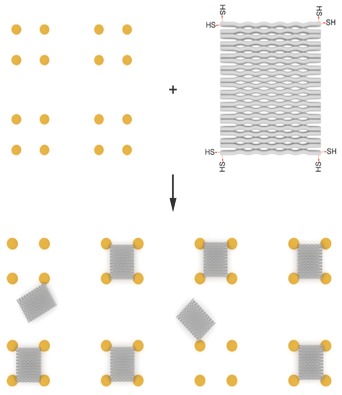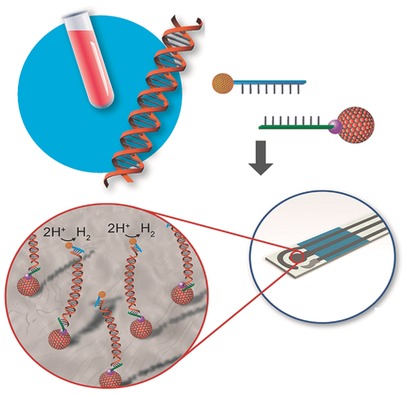Journal list menu
Export Citations
Download PDFs
Cover Picture
Blood Plasma Separation: Smart Pipette and Microfluidic Pipette Tip for Blood Plasma Separation (Small 2/2016)
- Page: 137
- First Published: 08 January 2016
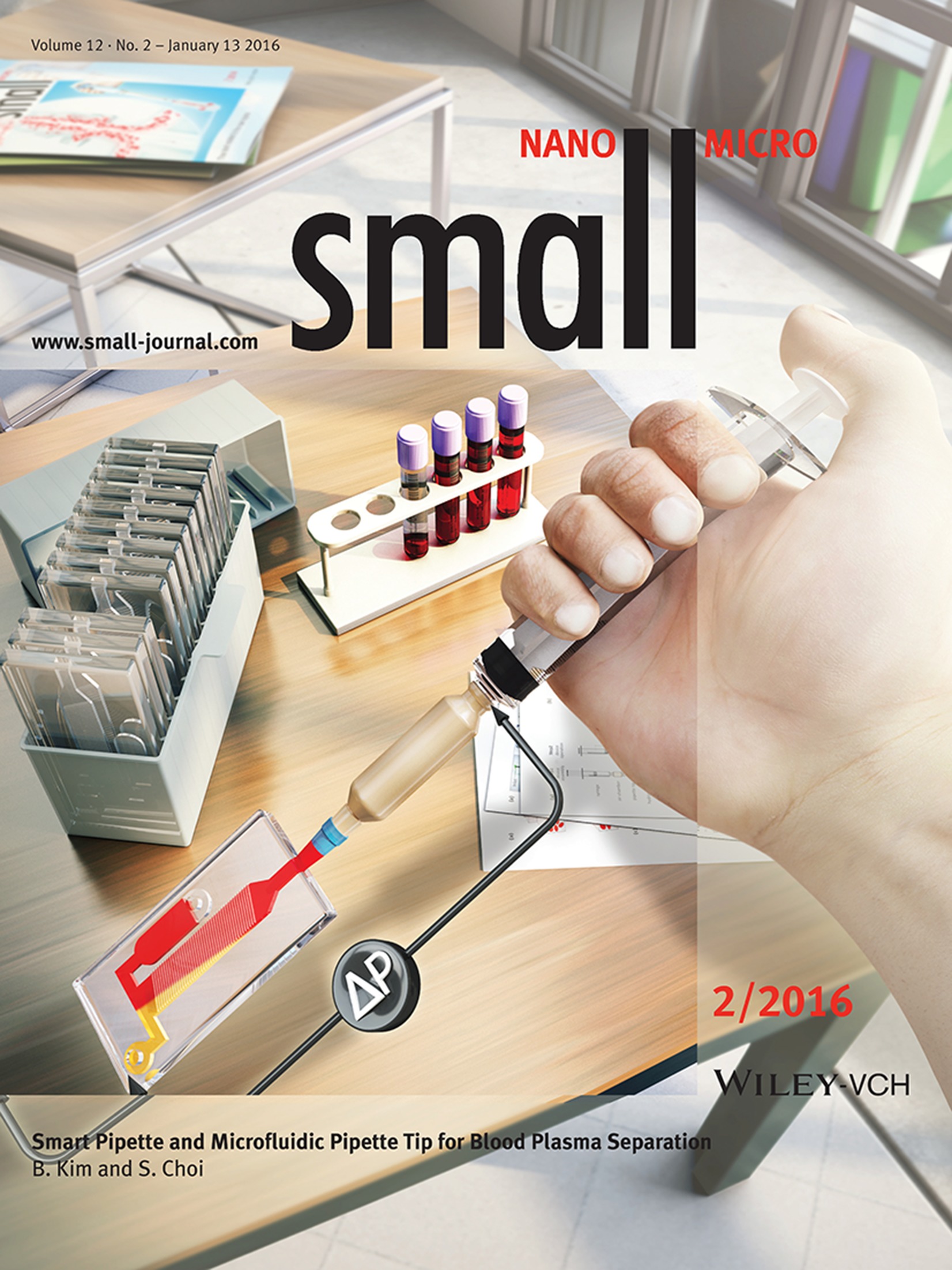
On page 190, B. Kim and S. Choi describe a method to separate blood plasma from whole blood through the combined use of a smart pipette and a microfluidic pipette tip. These combined devices are similar enough to a conventional pipette and pipette tip for users to be familiar with its use, so that non-experts can easily carry out the necessary procedures. This platform can therefore substantially contribute to gaining new insights into achieving a practical microfluidics implementation.
Inside Front Cover
Light-Emitting Diodes: Light-Emitting Diodes with Hierarchical and Multifunctional Surface Structures for High Light Extraction and an Antifouling Effect (Small 2/2016)
- Page: 138
- First Published: 08 January 2016
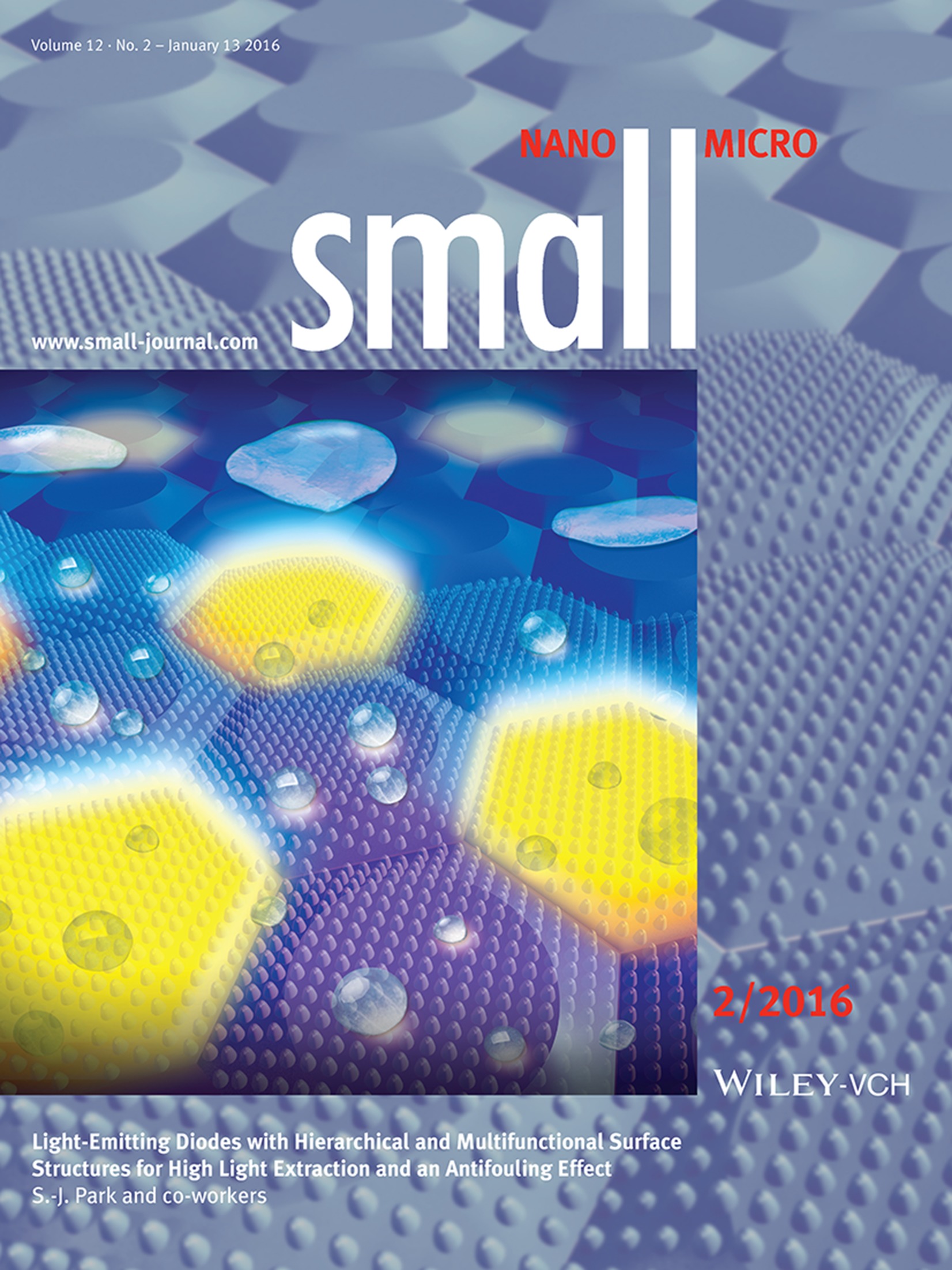
Bioinspired hierarchical structures on the surface of vertical light-emitting diodes (VLEDs) are fabricated by S.-J. Park and co-workers based on combining a self-assembled dip-coating process and nanopatterning transfer method using thermal release tape. These novel surfaces reduce the total internal reflection and grant additional antifouling abilities to VLEDs. On page 161, this provides a guideline for the design of various optoelectronic devices where not only high performance but also considerably reduced contamination by the environment are required for efficient LEDs with long operational lifespans.
Masthead
Contents
Reviews
Photoluminescence Architectures for Disease Diagnosis: From Graphene to Thin-Layer Transition Metal Dichalcogenides and Oxides
- Pages: 144-160
- First Published: 27 November 2015
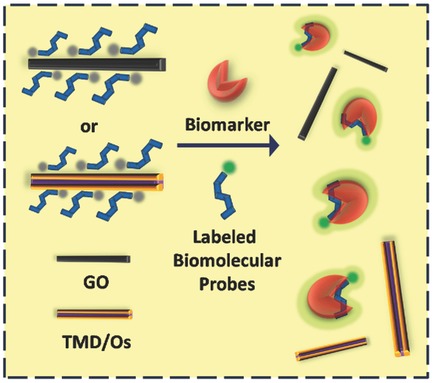
Developments in photoluminescence architectures, constructed by simple supramolecular self-assembly between graphene and graphene-like thin-layer materials and labeled biomolecular probes, are summarized. These material composites show a diverse range of diagnostic as well as theranostic applications, providing a new generation of promising tools for the clinical use.
Communications
Light-Emitting Diodes with Hierarchical and Multifunctional Surface Structures for High Light Extraction and an Antifouling Effect
- Pages: 161-168
- First Published: 17 November 2015
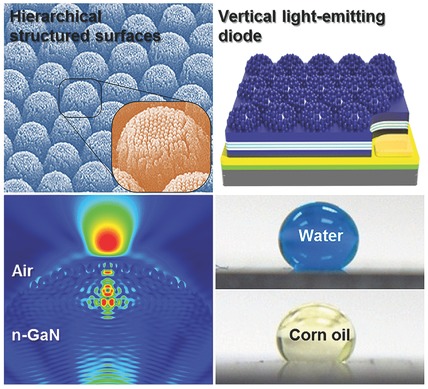
Bioinspired hierarchical structures on the surface of vertical light-emitting diodes (VLEDs) are demonstrated by combining a self-assembled dip-coating process and nanopatterning transfer method using thermal release tape. This versatile surface structure can efficiently reduce the total internal reflection and add functions, such as superhydrophobicity and high oleophobicity, to achieve an antifouling effect for VLEDs.
Suspending DNA Origami Between Four Gold Nanodots
- Pages: 169-173
- First Published: 17 November 2015
Effective Stabilization of a High-Loading Sulfur Cathode and a Lithium-Metal Anode in Li-S Batteries Utilizing SWCNT-Modulated Separators
- Pages: 174-179
- First Published: 18 November 2015
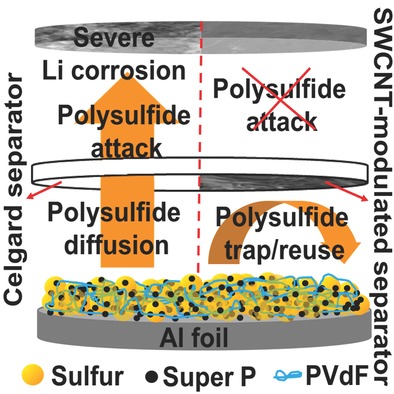
A custom single-wall carbon nanotube (SWCNT)-modulated separator is employed to directly suppress the polysulfide migration and indirectly protect the lithium-metal anode from severe polysulfide contamination. The conductive sp2-carbon scaffold continuously reactivates and reutilizes the trapped active material, so the SWCNT-modulated separator provides a facile way to facilitate the implementation of pure sulfur cathodes with high sulfur contents and loadings.
Fast and Efficient Fabrication of Intrinsically Stretchable Multilayer Circuit Boards by Wax Pattern Assisted Filtration
- Pages: 180-184
- First Published: 30 November 2015
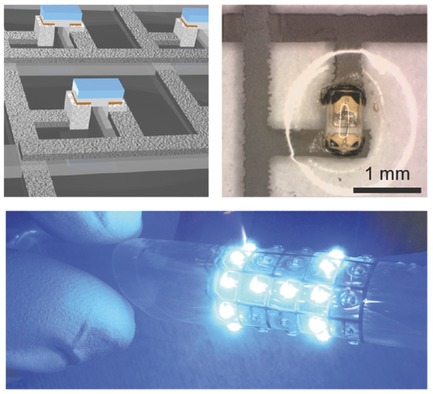
Intrinsically stretchable multilayer circuit boards are fabricated with a fast and material efficient method based on filtration. Silver nanowire conductor patterns of outstanding performance are defined by filtration through wax printed membranes and the circuit board is assembled by subsequent transfers of the nanowires onto the elastomer substrate. The method is used to fabricate a bright stretchable light emitting diode matrix display.
Free-Standing Graphene Thermophone on a Polymer-Mesh Substrate
- Pages: 185-189
- First Published: 30 November 2015
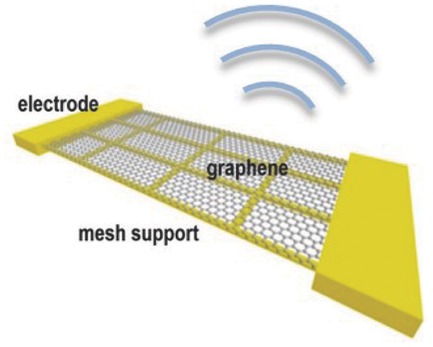
A graphene thermoacoustic loudspeaker with a thin polymer mesh is fabricated using screen-printing. An experiment with substrates of various free-standing areas shows that a higher sound pressure level can be achieved as compared to previously reported graphene thermoacoustic loudspeakers. Moreover, a modified equation to predict the sound pressure level of the thermoacoustic loudspeaker with a thin and patterned substrate is proposed and verified by experimental results.
Smart Pipette and Microfluidic Pipette Tip for Blood Plasma Separation
- Pages: 190-197
- First Published: 16 November 2015
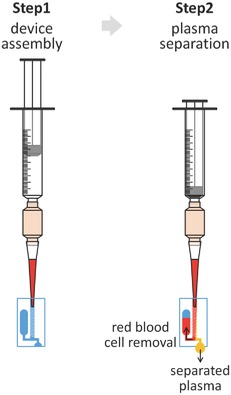
An integrated method for blood plasma separation is presented by combining a pneumatic device, which is referred to as a “smart pipette,” and a hydrophoretic microchannel as a microfluidic pipette tip for whole-blood sample preparation. This method enables hemolysis-free, high-purity plasma separation through smart pipetting of whole blood, potentially providing the means for rapid, inexpensive blood sample preparation for point-of-care testing.
Origin of Improved Optical Quality of Monolayer Molybdenum Disulfide Grown on Hexagonal Boron Nitride Substrate
- Pages: 198-203
- First Published: 25 November 2015
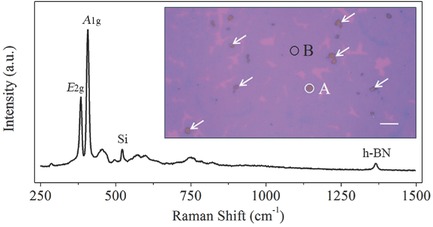
Monolayer MoS2 is synthesized on hexagonal boron nitride (h-BN) flakes with a simple, high-yield method. Monolayer MoS2 on h-BN exhibits improved optical quality. Combining the theoretical and experimental analysis, it is concluded that the enhanced photoluminescence and Raman intensities of monolayer MoS2 probably originate from the relatively weak doping effect from the h-BN substrate rather than the optical interference effect.
Frontispiece
Electrocatalytic Detection: Magnetic Bead/Gold Nanoparticle Double-Labeled Primers for Electrochemical Detection of Isothermal Amplified Leishmania DNA (Small 2/2016)
- Page: 204
- First Published: 08 January 2016

A novel design for isothermal amplification using primers labeled with both gold nanoparticles and magnetic microbeads is shown by A. Merkoçi and co-workers. On page 205, the amplified product carries both labels, allowing rapid purification and quantification. The magnetic properties of the first primer facilitate the purification/preconcentration of the amplified DNA through magnetic separation. The gold nanoparticles are easily quantified by simple electrocatalytic detection methods. Thus, the use of primers labelled with gold nanoparticles and magnetic microbeads turns isothermal amplification into a faster and easier qualitative and quantitative diagnostic method.
Full Papers
Magnetic Bead/Gold Nanoparticle Double-Labeled Primers for Electrochemical Detection of Isothermal Amplified Leishmania DNA
- Pages: 205-213
- First Published: 18 November 2015
Black Phosphorus (BP) Nanodots for Potential Biomedical Applications
- Pages: 214-219
- First Published: 20 November 2015
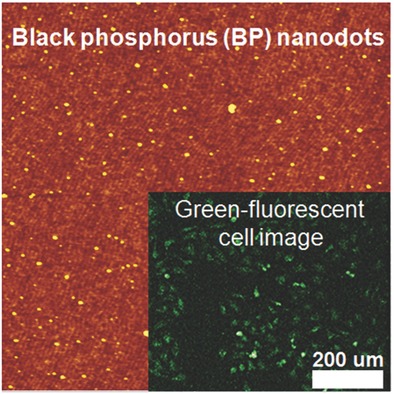
Black phosphorus (BP)-nanodots are prepared using a simple ultrasonication-assisted solution method. Compared to conventional semiconductor quantum dots, BP-nanodots present little in vitro cytotoxicity and further blue- and green-fluorescent bioimaging roles under excitations of UV and visible light, showing potential as novel drug delivery carriers in biomedical applications.
Binary Superlattices from {Mo132} Polyoxometalates and Maghemite Nanocrystals: Long-Range Ordering and Fine-Tuning of Dipole Interactions
- Pages: 220-228
- First Published: 18 November 2015

The successful coassembly of {Mo132} polyoxometalates (POMs) and γ-Fe2O3 magnetic nanocrystals (MNCs) is demonstrated. The POMs inserted in octahedral γ-Fe2O3 interstices act as binder constituents for the MNCs, leading to a long-range ordering. Depending on the POM size, such a structuring effect either preserves the magnetic properties of γ-Fe2O3 or results in a fine tuning of their dipolar interactions.
Single-Step Fluorocarbon Plasma Treatment-Induced Wrinkle Structure for High-Performance Triboelectric Nanogenerator
- Pages: 229-236
- First Published: 30 November 2015

A high performance triboelectric nanogenerator is fabricated following a simple method. Using a single-step fluorocarbon plasma treatment, a disordered wrinkle structure with a fluorocarbon polymer cover is formed. This method can dramatically increase the performance of the triboeletric nanogenerator more than eight-fold.
Frontispiece
Enantiomeric Nanostructures: Chiral Nanostructures from Helical Copolymer–Metal Complexes: Tunable Cation–π Interactions and Sergeants and Soldiers Effect (Small 2/2016)
- Page: 237
- First Published: 08 January 2016
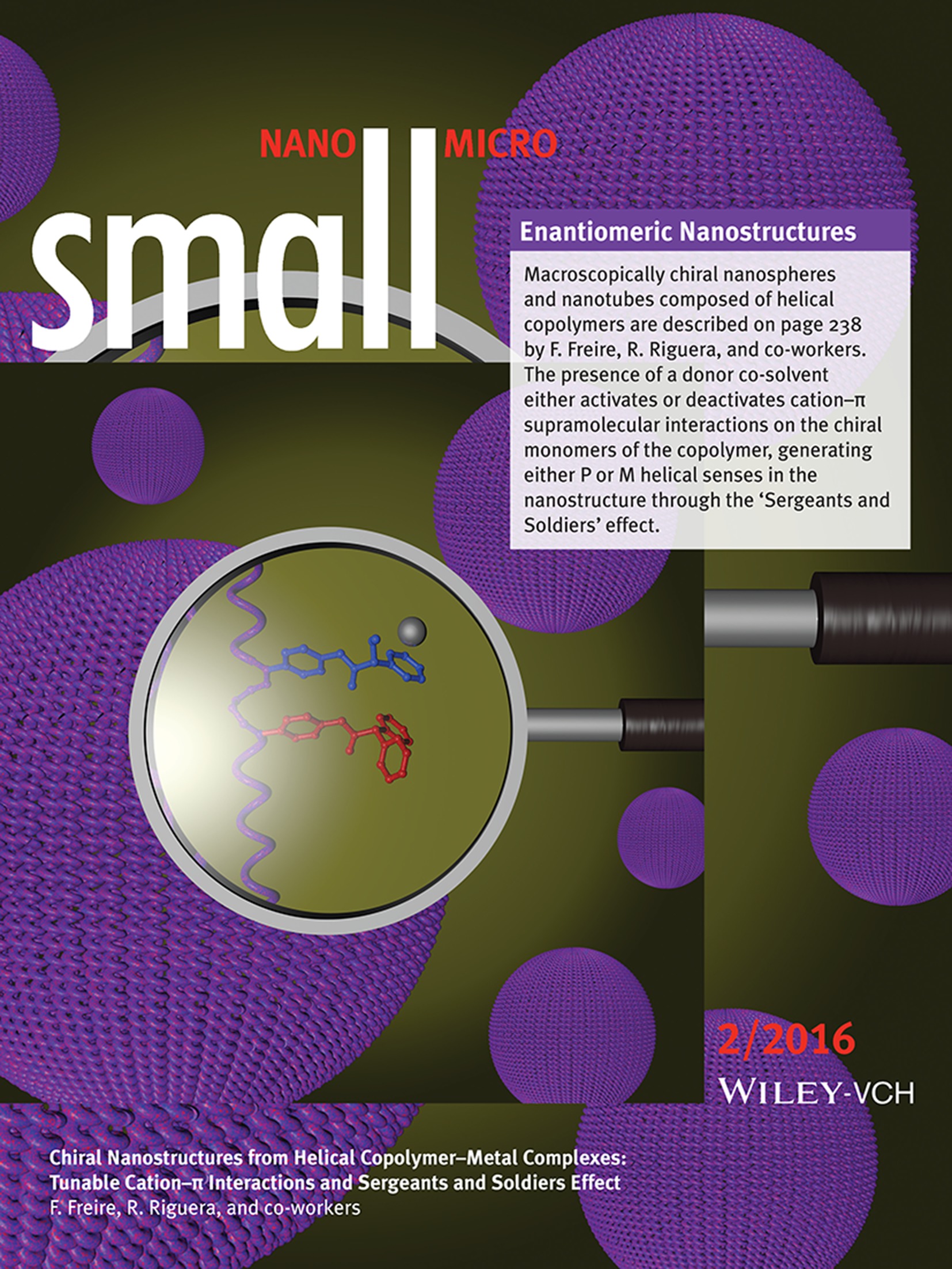
Macroscopically chiral nanospheres and nanotubes composed of helical copolymers are described on page 238 by F. Freire, R. Riguera, and co-workers. The presence of a donor co-solvent either activates or deactivates cation–π supramolecular interactions on the chiral monomers of the copolymer, generating either P or M helical senses in the nanostructure through the ‘Sergeants and Soldiers’ effect.
Full Papers
Chiral Nanostructures from Helical Copolymer–Metal Complexes: Tunable Cation–π Interactions and Sergeants and Soldiers Effect
- Pages: 238-244
- First Published: 18 November 2015

Mirror image nanostructures from a single helical copolymer–metal complex can be obtained by the presence of a certain amount of a donor cosolvent, which activate/deactivate cation–π supramolecular interactions on the chiral monomers of the copolymer. Those structural changes are transferred to the rest of the polymer chain inducing a selective P or M helical sense through the Sergeants and Soldiers Effect.
Self-Powered Photoelectrochemical Biosensor Based on CdS/RGO/ZnO Nanowire Array Heterostructure
- Pages: 245-251
- First Published: 30 November 2015

A CdS/RGO/ZnO nanoheterostructure is fabricated and then applied in the photoelectrochemical biosensing of glutathione. The biosensor is a self-powered device with fast response, certain selectivity, reproducibility, and stability. The linear detection range of the device is from 0.05 mm to 1 mm and the detection limit is 10 μm.
Postsynthesis of h-BN/Graphene Heterostructures Inside a STEM
- Pages: 252-259
- First Published: 30 November 2015
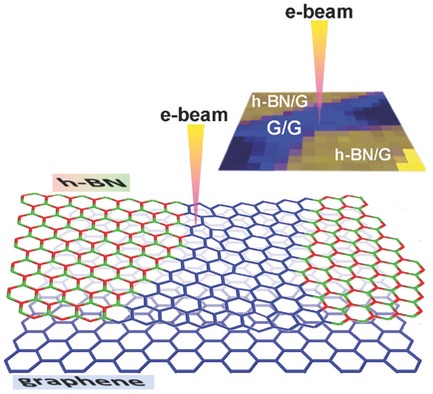
Atomic analyses of the in-plane growth of graphene from the step-edge of h-BN are performed using scanning transmission electron microscopy (STEM). By using a postgrowth method, graphene nanoribbons connecting the two h-BN domains and isolated carbon islands embedded in h-BN layer are produced. Electron energy loss spectroscopy results demonstrate an electronic coupling effect existing in graphene and h-BN heterostructure.





